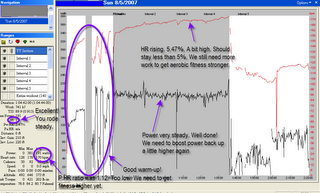Quick Race Analysis
 Above is the WKO+ power-heart rate graph of a 40km time trial from last Sunday done by one of the athletes I coach. She had a good race winning her category and finishing 4th overall. And bettered her time from the previous year. This despite not being even close to the fitness she had earlier in the season before she injured her foot by dropping a heavy object on it and losing several weeks of training. We're making good progress but we've got a ways to go with her training for late season races.
Above is the WKO+ power-heart rate graph of a 40km time trial from last Sunday done by one of the athletes I coach. She had a good race winning her category and finishing 4th overall. And bettered her time from the previous year. This despite not being even close to the fitness she had earlier in the season before she injured her foot by dropping a heavy object on it and losing several weeks of training. We're making good progress but we've got a ways to go with her training for late season races.
The graph includes my comments and provides great feedback on what we need to work on. We need to rebuild her pedal force to boost power and lift her cadence (it was 80 but obscured above). We also need to continue lifting her anaerobic threshold fitness. This is evident from the "decoupled" power and heart rate graphs. This should be less than 5% when in good shape. She did a great job of riding a steady TT as shown by her Variability Index ("VI") of 1.0.
Without this feedback she and I would only be guessing as to how her race went and what we need to work on.


5 Comments:
Hey Joe,
Three questions:
First, you mention that her power was very steady. I can "see" that by looking at the chart, but there has to be some mathematical formula that tells you that. What are you using?
Second, what P/HR ratio would you be satisfied seeing (considering that 1.12 was too low)? Does this ratio change for various race distances, say, 10K versus 40K versus 100 miles?
Third, what program are you using to analyze that data? training peaks?
I've heard a lot about training peaks but only recently purchased a powertap. Have been using poweragent software as it was free.
What additional pieces do you get from training peaks that a person doesn't get with free software? I'm trying to justify the purchase.
Thanks. Eric
What sort of power to heart rate ratio are you looking for?
Eric--1) Variability index tells me that. VI is noralized power divided by average power. I like to see it at less than 1.05 meaningless that 5% variance. 2) P:HR ratio varies by the individual and the type of steady state effort. I know she should have a P:HR a bit higher than that from experience working with her. 3) Cycling Peaks/WKO+ software. Training Peaks is not an analysis software but rather a logging and communications tool. CP/WKO is available through the TP website, tho. 4) The workout graphics you find used in my blog are from CP/WKO. No other free tools come even close to its analysis capabilities.
Sydney--See my answer #2 to Eric's Q above.
Every time I read this blog I seem to find a useful perspective on things... I'd never really used the average power over average HR, although I do track it on my climb log (...Click).
I know that this will be highly individual and tracking the values for yourself over time would be more important than comparing between athletes, but out of curiosity, what would you expect from a top well-trained athlete for: A 40km TT, and a +-10 minute maximal effort?
Ta,
Jean
Post a Comment
<< Home